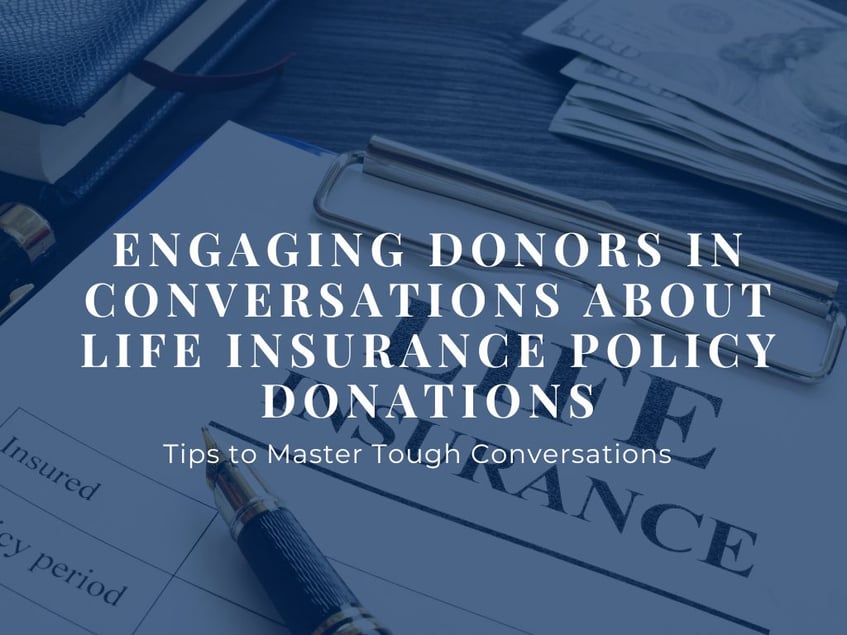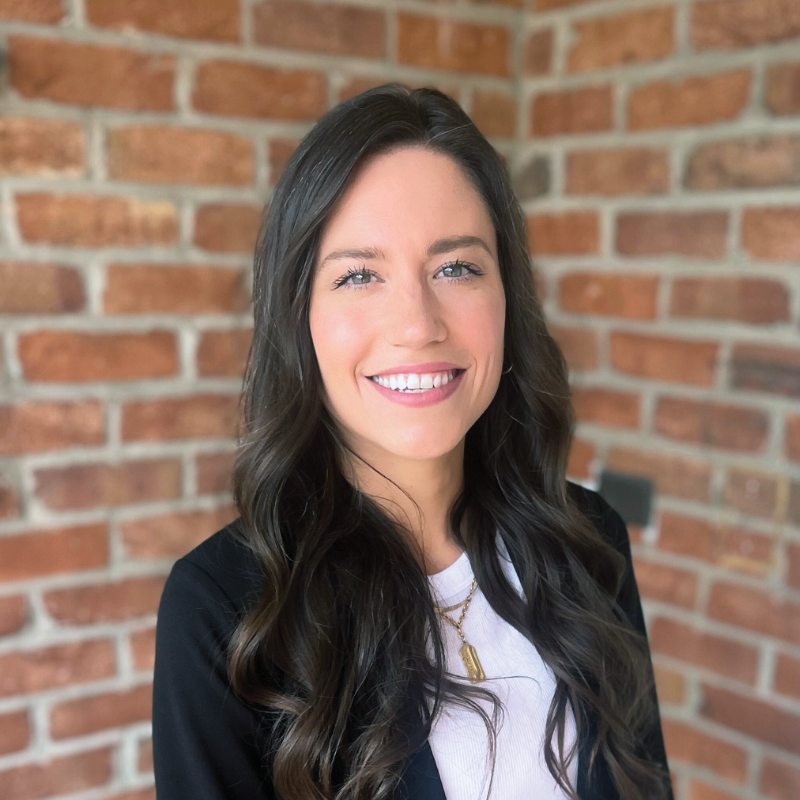
In life, there are many difficult discussions that are inevitable but affect us all. A topic that is among the most uncomfortable to discuss is the end of our life. This fact causes most fundraisers to shy away from discussing life insurance policy donations with donors. But as a nonprofit leader, you know that managing your nonprofit investments and finances is essential.
Did you know that by avoiding the topic, you are doing a disservice to both the donor and your organization?
If you haven’t incorporated life insurance policy donations into your overall fundraising plan, you are losing out on significant revenue potential for your organization. In addition, you are denying the donor the mental health and tax benefits that come with making a large impact. In this article, we’ll explain why you should be talking about life insurance policy donations with your donors, and give you six actionable tips to bring up this difficult topic.
Why You Should Talk About Life Insurance Policy Donations with Your Donors
There are many reasons why it is difficult to talk about death. But studies show that people are open to these conversations. According to a national survey by the Conversation Project, 92% of Americans say it’s important to talk about end-of-life care, and 53% would be relieved if a loved one started the conversation.
Additionally, according to a LIMRA Insurance Barometer Study, 54% of Americans were covered by some type of life insurance in 2020. If they have taken the steps to purchase a life insurance policy, that shows they are open to these types of discussions and would like to plan for the future.
If their children and/or spouse are well established and taken care of at this point in their life, the individual may not feel the need to provide that money for their security. If they have decided that the death benefit isn’t needed to keep their family stable, they may be excited by the idea of it helping their favorite organization!
As people get older, it is natural to consider the legacy they will leave. Many people want to make an impact but don’t know what that looks like or what to do. Give them the option of fulfilling their legacy by helping your mission, something that will last long after they’re gone!
You also don’t want to deny the donor any of the great benefits that come along with helping others. The Cleveland Clinic reports that giving even boosts your physical and mental health. Benefits include:
- Lower blood pressure
- Increased self-esteem
- Less depression
- Lower stress levels
- Longer life
- Greater happiness and satisfaction
Why not let the donor take advantage of these benefits now? Once they know their legacy plan is in place and helping their favorite cause, your donors will experience all the tremendous benefits associated with giving.
By avoiding talking to your donors about life insurance policy donations, you are choosing fear over helping your mission. Brene Brown, author and researcher on vulnerability, states in her book, Dare to Lead,
“Choosing our own comfort over hard conversations is the epitome of privilege, and it corrodes trust and moves us away from meaningful and lasting change.”
Don’t let your fear hold your organization back. By educating your donors on every option they have to support your mission, you unlock great potential for both the donor and your organization.
How to Talk About Life Insurance Policy Donations with Your Donors
Segment Your List
Life insurance policy donations will most likely come from your biggest fans. Take some time digging through your CRM or donations management system to identify donors that have been giving to your organization for several years. If their donation is at a high level or has increased over time, even better!
These are prime candidates for you to begin nurturing. Send these donors a short email series introducing them to the idea and impact others have made through life insurance policy donations. Or send a mailing with a powerful story about these types of donations with simple instructions to do it themselves. These donors have already proved they want to support your mission; now make sure they know all their options!
Know the Right Time and Place
The reason segmenting your list is important is because this isn’t necessarily “first date” talk. Unless your donor brings it up the first time you meet, we don’t suggest making this your first ask. This opportunity should be discussed with donors you have a meaningful relationship with.
Your donor should hear about this donation option at your organization many times before you actually make the ask. By including it in your overall fundraising plan (see below for more), this unique donation opportunity will already be planted in their brains. After hearing about it several times, their brain will start to tag the idea as “familiar” and be more receptive to it.
There is a time and a place for this discussion. A loud, public setting like a fundraiser or board meeting isn’t suitable for this caliber of ask. If possible, having these conversations in person can add a sense of humanity, as opposed to virtually or over the phone. You should choose a private setting where the donor is comfortable and relaxed. Remember to take into account religious holidays and cultural differences that may require a different date or setting.
Be Ready When the Opportunity Presents Itself
You do not want to be unprepared when a donor is ready to have this discussion. You should have your donation process documented for both the development professional and for the donor. Have easy-to-read instructions for the donor to follow to set up the donation, set up a landing page, and have your stewardship plan in place.
Being prompt is key to not losing an amazing gift like this. Include your nonprofit financial advisor in these discussions so they are prepared and can advise you on processes and best practices. Don’t have a nonprofit financial advisor yet? Schedule a consultation today to get started!
It is important that everybody be in the right state of mind for this discussion, both the donor and the development staff. Even though you are talking about somebody else’s mortality, this can bring up difficult feelings and thoughts for you too. Remember to stay focused and guide the conversation back to the cause (see below for more on this). You have one goal: to help further your mission by educating donors on how they can help!
Really Listen
Everybody has a different attitude, belief, and relationship with death. Some people are open to discussing it; some people shut down when it is brought up. It is up to you to read your donor. Pay attention to their nonverbal cues, such as body language, tone of voice, eye contact, or changes in behavior.
As we said above, your donor should hear about this type of donation several times before you make the ask. Even if they are the ones that initiated the meeting, remain compassionate and open. Listen to their needs, not yours. Your job is to provide the donor the education they need to make an informed decision on their charitable giving. The rest is up to them!
Remain engaged and show that you are listening by making eye contact, nodding, and smiling. You can use this as an opportunity to learn more about the donor and create an even deeper relationship with them. There is bound to be vulnerability in these discussions, and keeping a safe and open environment is key to a smooth process.
Guide the Conversation Back to the Cause
It can be easy to get distracted from why you are having this conversation: to support your cause. After you have listened (a lot) and it is your time to talk, remember to guide the conversation back to the mission. How will this major gift make an impact on your organization and the mission you serve? Share specific stories and examples of how you will use this money to help make the world a better place. Remind donors about the legacy they could leave!
When you are talking with your donor, use clear, honest language. Don’t use weird euphemisms or talk in circles because you don’t want to use a word like “death”. If you have your process clearly identified, have qualified your donor and prepared them for this discussion, you don’t need to beat around the bush.
If They Seem Uncomfortable, Stop
You should continue to monitor how the donor is feeling throughout the entire conversation. If at any point they seem uncomfortable or something seems off, stop the conversation. You can say, “I feel like this is an uncomfortable discussion for you right now. Would you like to learn more about how ________ donations help our organization?” This gives the donor an easy way to switch the conversation to a different topic but still learn about ways they can give, without feeling guilty. Instead, you could educate them on making a donation of stock, a recurring gift, sponsoring an event, etc.
Incorporate Charitable Donations of Life Insurance Policy into Your Fundraising Plan
By educating your donors about the benefits of charitable donations of life insurance policies, you can unlock a major revenue stream. Don’t let fear hold your organization back; instead, embrace hard conversations, knowing your organization will grow because of it.
Looking for a Financial Advisor for Your Nonprofit?
If you are currently looking for help with financial planning, contact us. We are happy to schedule an introductory meeting at your convenience.



